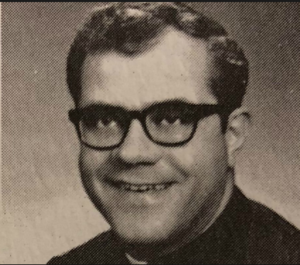Fr. Joseph Pease – Diocese of Harrisburg

Ordained: 1961
Inpatient evaluation: 1995
Removed: 2002
Assigned as follows:
- Our Lady of Lourdes (Enola, PA)
- St. Joseph (Mechanicsburg, PA)
- Divine Redeemer (Mount Carmel, PA) – after inpatient treatment
- Our Lady of Mount Carmel (Mount Carmel, PA)
- St. Theresa (New Cumberland, PA)
- St. John the Baptist (New Freedom, PA)
SUMMARY OF SEXUAL ABUSE ALLEGATIONS INVOLVING FR. JOSEPH PEASE:
The saga of Fr. Joseph Pease was examined in great detail by the grand jury as an example of the lengths the Diocese of Harrisburg – and other dioceses – will go to in order to prevent the scandal that child sexual abuse could bring to the Catholic Church’s bottom line.
-
Multiple allegations were made about Pease at least as early as 1995.
In 1995, the Diocese of Harrisburg received a letter from a former Mount Carmel high school teacher alleging that Pease was “a danger to the church.” The letter referred to Pease as a “known pedophile and transvestite.” It also referred to him being “bailed out” by a bishop, suggesting either a previous problem in Mount Carmel that was “fixed” by the bishop or that the priest was, in fact, arrested in Mount Carmel. The letter was signed by the author, “and concerned parents and grandparents of the region.” While a memo in the file indicates that the Chancery in Harrisburg reviewed Pease’s file in light of the allegations made, it does not appear that any further action was taken.
The following month, a man contacted the Diocese of Harrisburg at the direction of his parish priest to report that he was sexually abused by Joseph Pease at St. Paul’s in Atlas, Pennsylvania, which does not appear on the assignment history disseminated by the Diocese of Harrisburg in August 2018. The man alleged that he was 13 when the abuse started in 1971, and that it continued for two years. Under the guise of asking the child if he had ejaculated yet, Pease reached into the boy’s pants and fondled his penis. He then forced the boy’s hand into his own pants to masturbate himself. Other incidents, some of which occurred on a boat Pease owned with another accused priest (Francis Bach), involved oral sex. The man also explained that he did not realize that Pease was still in active ministry. Indeed, Pease had recently been assigned to a parish where the man’s 12 year old nephew was an altar server.
When confronted with the man’s allegations, Pease admitted to knowing him as a child, but denied any type of sexual contact. Instead, he said that he recalled one time that they were in a car and the victim laid his head in Pease’s lap. He also says that he found the boy inexplicably naked in the church rectory one time. He confirmed that he brought the boy to a boat owned by Bach. But, “in spite of these bizarre statements by Pease, [the Bishop] took no immediate action to remove Pease from ministry.” When contacted by a Chancery official who called Pease a few days later to inquire how he was doing, Pease told him that anything he did with the victim was “misinterpreted” by the victim. He also stated that he was drinking heavily during that time and had no control over himself. When asked point-blank “if sexual behavior with young obys could have happened…Pease replied, ‘I don’t know’ with nervous laughter….Pease further stated, ‘I hate to go on record accusing myself. You know when you are drinking you are not in control as much, not thinking correctly. With kids I was usually a little more discreet.’” When pressed about the incident involving the naked boy in the rectory, Pease rambled and said, the victim “must have gotten excited. I must have turned him on more than I thought.”
-
The Diocese of Harrisburg sent Pease for a psychological evaluation to clear him for a return to ministry and limit its own potential liability despite red flags that Pease posed a danger to children.
In September 1995, Pease was sent to Anodos Center for a psychological evaluation. The stated purpose, according to Diocese of Harrisburg records, was to determine “if there are any reason the diocese should be concerned about present or future ministry. At the present time he is in an active assignment as a pastor.”
In a letter to Anodos Center outlining what was known about Pease’s abuse history, the Diocese of Harrisburg stated, “At this point we are at an impasse- allegations and no admission. What we are hoping to accomplish through this assessment and other inquiries is to establish a foundation on which to send should reports begin to circulate about the alleged misconduct and questions are asked as to why Father has been retained in ministry.”
When Anodos Center failed to diagnose Pease with any type of mental health disorder, the Diocese of Harrisburg met with the victim and told him that there was no reason to continue Pease’s suspension from ministry; he would be assigned to a new parish as soon as he returned to Harrisburg.
Pease continued in active ministry until late 2002, when the Diocese of Harrisburg was contacted by an attorney for another victim of Pease.
-
The 2002 allegations that led to Pease’s removal from ministry in the months after the Archdiocese of Boston scandal became widely-known.
In September 2002, the Diocese of Harrisburg was contacted by an attorney for another victim of Pease. The grand jury report provides very few details about the allegations themselves, except to say that the abuse occurred in or around 1972.
Notably, the Boston Globe’s Spotlight team had exposed a culture of abuse and coverup in the Archdiocese of Boston in the early months of 2002, shortly before the attorney contacted the Diocese of Harrisburg. The Boston scandal was regular and repeated news stories across the nation by that time. The grand jury deduced that the Diocese of Harrisburg responded to this newest allegation against Pease differently because of the spectre of the negative press that could attach to it if it continued to protect Pease unconditionally.
Indeed, the Bishop of Harrisburg ordered an investigation of the newest allegation. When confronted, the elderly priest admitted to the allegation that he sexually abused this particular child. In December 2002, the Bishop of Harrisburg suspended his faculties and removed him from his parish.
In January 2003, Pease was allowed to retire voluntarily. He remained a priest of the Diocese of Harrisburg, no doubt receiving a pension and benefits.
Notably, in the weeks that followed his retirement, the Chancellor of the Diocese of Harrisburg opened a new investigation relating to another priest (John Allen), when one of the priest-witnesses they interviewed offered up information about Pease. According to the priest-witness, whose name was not disclosed in the grand jury report, he was aware of Pease’s abuse of children even earlier than 1995 because Pease had told him about multiple instances of having sexual contact with children. The priest-witness placed these conversations around 1993.
-
Bishop Gainer requests Vatican restrictions: the “poorly worded form letter” that the Grand Jury saw right through.
Pease was removed from ministry and his faculties revoked in 2002. He remained a member of the priesthood and, as a result, the financial and legal responsiblity of the Diocese of Harrisburg.
According to recent statements by the Diocese of Harrisburg, in 2014 new Bishop Ronald Gainer ordered a review of the status of all living priests accused of sexual misconduct, including Pease. When it was determined that he was still technically a priest but “of diminished mental capacity,” according to the Diocese of Harrisburg, Gainer sought guidance from the Vatican on how to resolve Pease’s status. The Vatican agreed with Gainer’s request to restrict Pease to a life of penance and prayer, meaning that he could never again function as a priest.
Gainer’s letter to Vatican requesting the restrictions drew criticism from the media, and rightfully so, as it suggested that Pease “be permitted to live out his remaining years in prayer and penance, without adding further anxiety or suffering to his situation, and without risking public knowledge of his crimes.” When accused of trying to orchestrate continued coverup of Pease’s misconduct, Gainer stated that it was merely “a poorly worded form letter.”
More importantly, the grand jury took exception with the wording employed by Bishop Gainer in his request to suspend any Canonical proceedings against the elderly priest. Specifically, they singled out the following justification: “‘…I believe that the harm done by his past sexual misconduct is being sufficiently repaired [by keeping him out of ministry]. Therefore, before God, Your Eminence, and in all good conscience, I am not requesting at this time, that any judicial trial or administrative process be initiated that may lead to his dismissal from the clerical state.’”
The grand jury summed it up perfectly: the Diocese of Harrisburg has only been concerned about protecting the Diocese of Harrisburg.
After a review of the documents and hearing extensive testimony about the handling of sexual abuse allegations in the Diocese of Harrisburg, the grand jury wrote:
“A thoughtful consideration of these facts, and a real concern for the welfare of children, should have resulted in a report to law enforcement, notice to Pease’s past parishes, and a meaningful investigation into the existence of additional potential victims. Instead, the Diocese began plans to utilize a “treatment facility” to treat priests, such as Pease, who were accused of sexual abuse. These facilities were observed throughout the Grand Jury’s investigation… These entities relied almost entirely on the priests self-reporting their request for treatment. When a priest denied allegations of sexual abuse, he usually avoided any diagnosis related to the sexual abuse of children. Moreover, these institutions focused on a clinical diagnosis over actual behavior as reported by the victims. Put plainly, these institutions laundered accused priests, provided plausible deniability to the bishops, and permitted hundreds of known offenders to return to ministry.”
The grand jury report continued, “The Grand Jury disagrees [that the harm done by Pease’s sexual misconduct is being healed by his removal from ministry]. While removing Pease from ministry was a start, he was clearly unfit to carry the title of priest. Moreover, public knowledge of Pease’s crime is exactly what was required in service to the public and Pease’s victims. Therefore, the Grand Jury details the case of Father Pease, as permitted by law, in service to the victims and the Commonwealth of Pennsylvania.”
Pease is alive and is believed to be residing in a retirement home for priests run by the Diocese of Harrisburg, though the exact extent of his daily monitoring is unknown. He may be free to come and go as he pleases without having to report where is going or with whom he has had contact (e.g., children). He is believed to be approximately 87 years old.
UPDATE: On December 14, 2018, it was reported that Bishop Gainer was asking the Vatican to defrock Father Pease on account of “new information about Pease” that came to light in the Grand Jury report.
Horowitz Law is a law firm representing victims of sexual abuse in the Diocese of Harrisburg and throughout Pennsylvania. The Diocese of Harrisburg filed for federal bankruptcy protection in February 2020. Anyone sexually abused by a priest or employee of the Diocese of Harrisburg may be entitled to file a claim against the Diocese in these bankruptcy proceedings, but very strict filing deadlines apply. Most victims of abuse in the Diocese of Harrisburg will never be able to take action against the Diocese of Harrisburg if they miss this bankruptcy filing deadline, so it is important that you contact us immediately to discuss your potential case.
Contact us at 888-283-9922 or [email protected] to discuss your legal options today.
